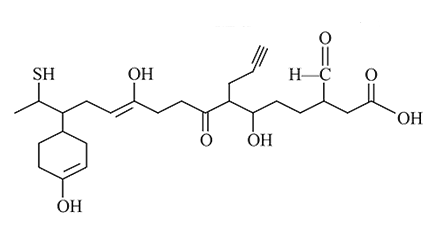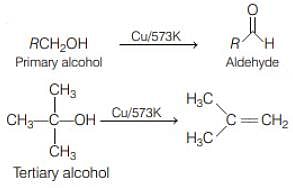Test: Reactions of Alcohols - JEE MCQ
20 Questions MCQ Test Chemistry for JEE Main & Advanced - Test: Reactions of Alcohols
Dehydration of alcohols by conc.  takes place according to following steps:
takes place according to following steps:

The slowest and fastest steps in the above reaction are
 takes place according to following steps:
takes place according to following steps:
The slowest and fastest steps in the above reaction are
| 1 Crore+ students have signed up on EduRev. Have you? Download the App |
The most probable product in the reacion given below is


Which of the following alcohols is dehydrated most readily with conc. 
Which one of the following compounds has the most acidic nature?
Arrange the following in increasing order of their acidity?
(a)  -cresol, (b) salicylic acid, (c) phenol
-cresol, (b) salicylic acid, (c) phenol
An organic compound  reacts with methyl magnesium iodide to form an addition product which on hydrolysis forms the compound
reacts with methyl magnesium iodide to form an addition product which on hydrolysis forms the compound  . Compound
. Compound  gives blue colour salt in Victor Meyer's test. The compounds
gives blue colour salt in Victor Meyer's test. The compounds  and
and  are respectively
are respectively
The strongest acid among the following aromatic compounds is
Methyl alcohol can be distinguished from ethyl alcohol using
The reagent which easily reacts with ethanol and propanol is

Find out number of reagents that can be used for above transformation from following
 ,
, 
Find number of moles of  obtained when
obtained when  of the given compound reacts with excess of
of the given compound reacts with excess of 

An alcohol on oxidation is found to give  and
and  . The structure of the alcohol is
. The structure of the alcohol is
Dehydration of cyclopentyl carbocation with conc.  forms
forms
|
352 videos|596 docs|309 tests
|
|
352 videos|596 docs|309 tests
|




 molecule. It is slowest step. Step 4 involves the conversion of an unstable (or intermediate) into a quite stable product, hence it is fastest step.
molecule. It is slowest step. Step 4 involves the conversion of an unstable (or intermediate) into a quite stable product, hence it is fastest step.


 in the following reaction is
in the following reaction is


 rather than bulky
rather than bulky 
 and
and  are
are  More the possibility for the dispersal of the negative charge, weaker will be the base. Thus the relative basic character of the four bases is
More the possibility for the dispersal of the negative charge, weaker will be the base. Thus the relative basic character of the four bases is

 in the following sequence of reactions?
in the following sequence of reactions?
 has an alcoholic group. This set of reactions is possible only when
has an alcoholic group. This set of reactions is possible only when  is
is  .
.
 and
and  cannot be converted back into
cannot be converted back into  by the given series of reactions.
by the given series of reactions. is an electron-donating group so its acidity is the least. Salicylic acid has two electron-donating groups so its acidity is the highest.
is an electron-donating group so its acidity is the least. Salicylic acid has two electron-donating groups so its acidity is the highest.
 is a Sec. alcohol since it gives blue colour in Victor-Meyer test and Sec alcohol are obtained by the action of
is a Sec. alcohol since it gives blue colour in Victor-Meyer test and Sec alcohol are obtained by the action of  on an aldehyde other than formaldehyde.
on an aldehyde other than formaldehyde. is Isopropyl Alcohol
is Isopropyl Alcohol
 reacts with
reacts with 


 (yellow ppt)
(yellow ppt) No ppt.
No ppt.
 and
and  .
. .
.
 forms a cyclic compound. Write the structure of the product.
forms a cyclic compound. Write the structure of the product.

 alcohol oxidizes but
alcohol oxidizes but  does not.
does not. and
and  in the following reactions?
in the following reactions?

 dehydrogenation takes place and an aldehyde is formed. In case of tertiary alcohols dehydration take place.
dehydrogenation takes place and an aldehyde is formed. In case of tertiary alcohols dehydration take place.














